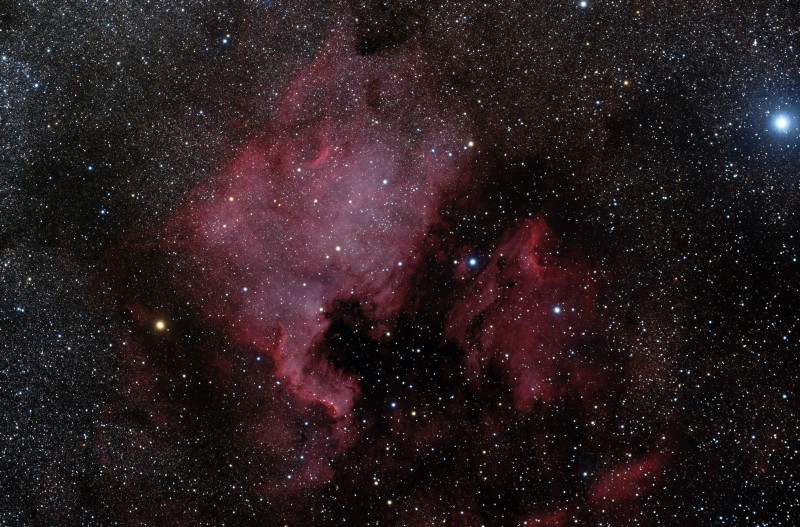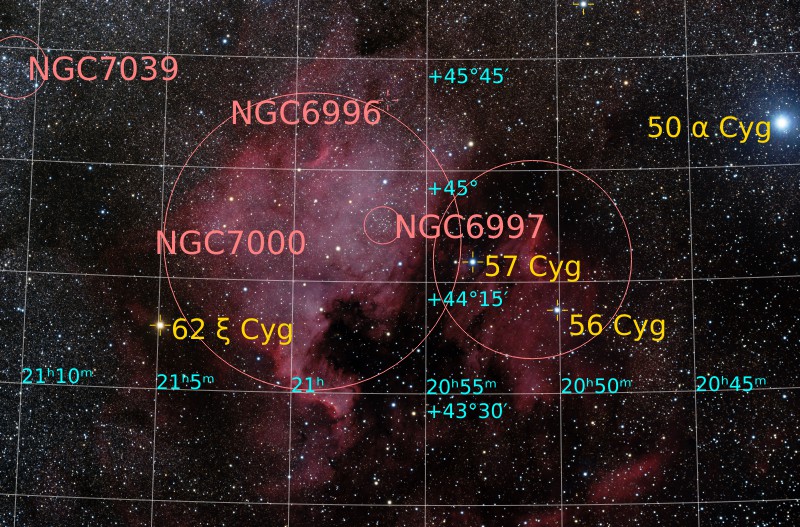This is the object that got me hooked on astrophotography. Well, sort of. I started a long time ago with a Pentax 35mm film camera and a CG5 mount and tried to take a picture of Cygnus. It was horribly underexposed, but one of the frames had just enough exposure to make out the North America nebula along with the constellation outline. I was hooked.
| Object | NGC 7000, H-alpha region in Cygnus |
| Camera | ASI2600MC |
| Lens/Scope | Redcat 51, 250mm F/L @f5 |
| Exposure | 15 x 10 minutes |
| Location | Cherry Springs State Park, PA |
| Processing | PixInsight, separated color channels for stacking via Normalized Scale Gradient |
I’ve been trying to get a better handle on processing by going through Adam Block’s tutorials and consider them well worth the money. At times he’s a bit to pedantic with his tutorials but the only worse than that would be skipping things assuming I know them; I’d rather find myself bored with him going too slow than going “wait, how did you do that?”
The image scale at 250 mm is severely undersampled which makes it a bit tricky to do both noise reduction and sharpening, and Adam’s tutorial were incredible helpful in basic things along the lines of “play with the parameters and see what works.”. Even with the undersampled star images, there are things you can do to for noise reduction and deconvolution even if they don’t really show at this image scale (downsampled 5:1).
On the other hand, one thing I always struggled with was shadow detail and ending up with the “picket-fence” in my histogram after stretching. I don’t remember exactly which tutorial it’s in, but Adam covers that at one point, almost in passing, but still being very clear. The key was the dynamic range extension when I’ve got shadow detail I want so separate from the noise. The 150 minutes of exposure for this fairly bright object still has enough noise that that was necessary and that made a huge difference in the smooth brightness transitions in the nebula.
Written by Roland Roberts
Search
.Archives
- May 2025 (1)
- October 2024 (1)
- May 2024 (2)
- April 2024 (3)
- September 2022 (5)
- April 2022 (1)
- January 2022 (3)
- December 2021 (4)
- September 2021 (3)
- July 2021 (1)
- January 2021 (1)
- November 2020 (2)
- October 2020 (2)
- September 2020 (2)
- August 2020 (5)
- July 2020 (1)
- November 2019 (2)
- September 2019 (1)
- August 2019 (2)
- September 2017 (1)
- August 2017 (1)
- September 2015 (3)
- August 2015 (2)
- June 2015 (5)
- May 2015 (3)
- May 2013 (2)
- January 2013 (1)
- December 2012 (2)
- September 2012 (1)
- June 2012 (1)
- May 2012 (1)
- October 2011 (2)
- September 2011 (2)
- April 2011 (2)
- March 2011 (10)
- January 2011 (8)
- November 2010 (2)
- October 2010 (1)
- September 2010 (3)
- August 2010 (2)
- July 2010 (1)
- June 2010 (1)
- April 2010 (3)
- February 2010 (3)
- January 2010 (3)
- December 2009 (6)
- November 2009 (3)
- October 2009 (7)
- September 2009 (8)
- August 2009 (4)
- July 2009 (1)
- June 2009 (2)
- May 2009 (2)
- April 2009 (7)
- March 2009 (1)
- February 2009 (6)
- January 2009 (4)
- December 2008 (4)
- November 2008 (3)
- October 2008 (11)
- September 2008 (4)
- August 2008 (5)
- July 2008 (5)
- June 2008 (2)
- April 2008 (4)
- March 2008 (18)
- February 2008 (9)
- November 2007 (1)
- October 2007 (3)
- July 2007 (3)
- April 2007 (1)
- March 2007 (6)
- February 2007 (3)
- December 2006 (3)
- October 2006 (4)
- September 2006 (1)
- July 2006 (5)
- May 2006 (10)
- April 2006 (9)


